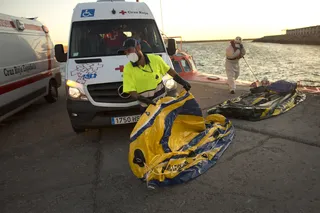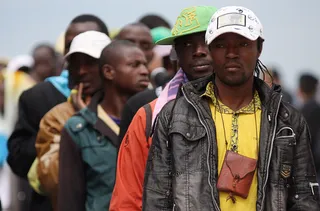Swallowed by the Sea: A Look at Recent Migrant Ship Deaths
About 2,900 asylum seekers have drowned at sea this year.

1 / 13
Dangerous Waters - This year alone, more than 130,000 migrants — mostly African — have fled conflicts, persecutions and feared economic chaos in their homelands, arriving on European shores in search of a better life. Yet, these migrants run a high risk of perishing at sea when they attempt to cross the Mediterranean, dubbed the “most deadly stretch of water for refugees and migrants” by the United Nations. Keep reading to learn about recent and past tragedies where desperate travelers were swallowed by the sea. — Patrice Peck and Natelege Whaley(Photo: FILIPPO MONTEFORTE/AFP/Getty Images)

2 / 13
A Deadly Year - Following two shipwrecks the week of Sept. 16, the Associated Press reported that 2014 is on track to become the deadliest ever for migrants crossing the Mediterranean Sea. Up to 700 migrants fleeing their homes of Syria, Palestine, Egypt, Sudan and other African countries are feared dead. Since the start of the year, more than 2,500 refugees and migrants have died trying to cross the Mediterranean.(Photo: Sergio Camacho/Getty Images)
Photo By Sergio Camacho/Getty Images

3 / 13
Growing Death Tolls - On Sept. 15, Angelina Jolie, who serves as Special Envoy for the United Nations High Commission for Refugees, met with officers in the Maltese military to discuss rescue at sea operations for the hundreds of refugees shipwrecked the previous week. According to the Associated Press, more than 20,000 people have died in the past two decades attempting to reach the Italian coast, including 2,300 in 2011 and about 700 in 2013.(Photo: AP Photo/Pete Muller/UNHCR)

4 / 13
Haitian Migrants Perish - Eighteen Haitian migrants drowned after their sailboat capsized off the coast of Turks and Caicos, a British territory, on Dec. 25, 2013. Authorities rescued 32 people. The boat was being escorted by a marine unit of Turks and Caicos police when it overturned, according to the Associated Press. (Photo: BBC News)

5 / 13
Scores Dead After Boat Sinks - Hundreds of Eritrean, Somali and Ghanaian migrants in Tripoli boarded a fishing boat headed for the tiny Italian island of Lampedusa only to be swallowed by the sea after an onboard fire led to the ship’s capsizing and sinking on Oct. 3, 2013. At least 114 people, including most of the women and all of the children, were declared dead and scores more missing, reported the Associated Press. Only 159 passengers were rescued, with the death toll expected to rise.(Photo: AP Photo/Nino Randazzo, Health Care Service, HO)
ADVERTISEMENT

6 / 13
Only Caskets - "We need only caskets, certainly not ambulances," said Pietro Bartolo, the chief of Lampedusa health services, about the Oct. 3, 2013, disaster at sea. This tragedy reflects an ongoing global phenomenon in which people pay thousands of dollars and risk their lives aboard jam-packed dinghies and flimsy boats to get smuggled into the European Union.(Photo: AP Photo/Nino Randazzo, Health Care Service, HO)

7 / 13
The Gateway - Positioned closer to Africa than Europe, Lampedusa has been at the center of Europe’s illegal immigration issue for more than a decade, Time magazine reported. Thousands of migrants live in makeshift settlements throughout the area, outnumbering the island’s 6,000 residents.(Photo: Giorgio Cosulich/Getty Images)

8 / 13
Terrible Conditions - The U.N. Refugee Agency has repeatedly criticized Lampedusa for the poor conditions of its temporary reception center and for sending many asylum applicants back home.(Photo: AP Photo)
Photo By Photo: AP Photo

9 / 13
Top Destination - Italy, in general, has been struggling with the recent surge of migrants from the horn of Africa and the northern region of the continent, particularly those nations embroiled in conflict since the start of the Arab Spring in late 2010 and the Israel-Palestine crisis.(Photo: Giorgio Cosulich/Getty Images)

10 / 13
Dead At Sea - The unrest in Libya caused more than 250 Eritrean and Somali refugees to flee the North African country on April 6, 2011. At least 150 passengers drowned after their boat capsized near Lampedusa.(Photo: FILIPPO MONTEFORTE/AFP/Getty Images)
ADVERTISEMENT

11 / 13
Scores Drown After Boat Sinks - On June 2, 2011, more than 800 migrants, mainly from sub-Saharan Africa, were also on their way to Lampedusa from Libya when their boat capsized and sank off the Tunisian coast, about 19 miles away from the coveted destination. While nearly 600 people were rescued from the ill-fated boat, those reported missing — more than 200 people — were presumed dead.(Photo: ALBERTO PIZZOLI/AFP/Getty Images)

12 / 13
Water Graveyards - After drifting aboard a Lampedusa-bound boat for 16 days in open waters, 61 of 72 migrants on board died throughout March and April 2011. Predating this disaster and emphasizing the prevalence of this crisis are the deaths of 50 North African migrants and roughly 283 South Asian migrants in June 2003 and December 1996, near Lampedusa and Portopalo, Sicily, respectively.(Photo: Tullio M. Puglia/Getty Images)
